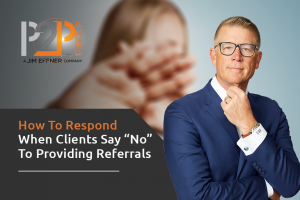Straight To Voicemail? Here’s How To Keep Meetings From Referrals

With today’s technology and caller ID, you’ll reach referrals on new prospective client calls only 20% of the time.
It’s not because they’re not there when you call. Rather, it’s because they don’t recognize your number. They’re not waiting for your call, and you did not get the right nomination.
Or, it could be instead that you called the wrong number—perhaps you have a work line instead of a cell phone, or you have a cell phone instead of a work line.
Regardless, they didn’t answer. Now, you're left hoping that the voicemail you leave is enough to bring your first meeting to fruition.
On average, you should make appointments with new prospective clients 50% of the time when you reach them. Using these numbers, if you make 30 phone calls in an hour, you would most likely have six conversations. That’s 20% of the 30 calls.
Out of those six conversations, you should end up with three appointments from those six, which is 50%. It’s important to know and track those numbers, because that determines whether your efforts are working.
However, how should you handle the 80% of the individuals that go straight to voicemail? Here are two “tricks of the trade” that you can use to help reach your monthly targets. One is on leaving messages and the second is on confirming appointments.
Leave A Voicemail That Leverages The Nominator
A lot of reps ask me, “Hey, how often should I be leaving messages?”
That’s somewhat of a gray area. You certainly don’t want to leave more than one message per day, because it may look as if you’re stalking them. You probably don’t want to leave a message more than once every three business days, but you’ll have to play with that and see what works best for you.
When you do leave a message, here is what I find works the best: If Mary Jones referred me to Bill Smith, and I needed to leave him a message, I would say:
“Hey, Bill, it’s Jim Effner, financial advisor with such and such company. I’m calling on behalf of the nomination I received from Mary Jones. I believe she’s already reached out to you and told you I’d be calling, but do me a favor if she hasn’t. Please pick up the phone and give her a call first. She’ll bring you up to speed with what this is all about, and then go ahead and call me. Here’s my number. I can’t wait to hear from you.”
That tends to force a conversation between the referral and the nominator, and I find that works well.
Confirm Your Appointments With Assumed Consent
When leaving a message to confirm an appointment, you should assume consent. The only reason you’re calling is to clarify the address.
Thus, if I’m calling Bill Smith to confirm an appointment tomorrow in my office at 2 o’clock, I don’t call him and say, “Hey, Bill, it’s Jim. I just want to make sure we’re still on. Are we still good?” This approach gives them an out.
Instead, I leave this message, “Hey, Bill, I’m super excited about our meeting. I can’t wait to meet you. I have heard such great things about you. Our meeting is at 2 o’clock, but I couldn’t remember if I gave you my address, so I simply want to get back to you. Again, here it is. See you tomorrow!”
That is a much more effective way to confirm appointments, as opposed to asking them if you’re still meeting.
The Purpose Of Phoning
Always remember that the only purpose of phoning is to get an appointment. It’s not to sell financial products or yourself.
When you have that mentality, your messages become succinct, clear, and compelling, which allows you to place significantly more calls per day. It also allows you to project a professional and energetic tone to your clients.
Lastly, understand that if you never get in front of a client, nothing will happen. However, if you successfully get in front of a client, you can change their life.
This mindset will provide the intensity needed to be far more effective while phoning referrals, leaving messages and confirming appointments.
[wd_hustle id=my-newsletter! type=embedded]
Recent Posts
[Sassy_Social_Share type="standard" url="http://jimeffner.com/voicemail-keep-meetings-from-referrals"]





